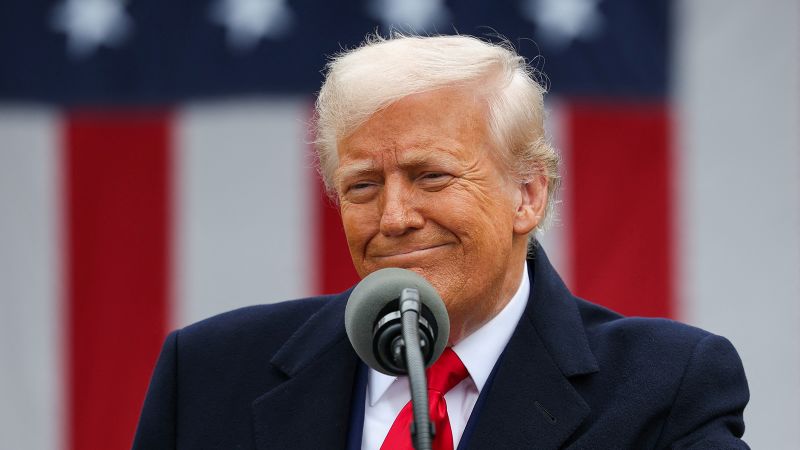Trump's Tariffs: Separating Reality from Rhetoric
Editor’s Note: The ongoing debate surrounding the economic impact of the Trump administration's tariffs continues to generate headlines. This article analyzes the actual effects versus the initial claims.
Why This Matters
The Trump administration's imposition of tariffs on various goods sparked significant controversy. Understanding the true impact of these trade policies is crucial for businesses, policymakers, and consumers alike. This analysis examines the rhetoric surrounding the tariffs – promises of job creation and economic growth – against the reality of their consequences, considering factors such as inflation, trade deficits, and the impact on specific industries. Keywords: Trump tariffs, trade war, economic impact, inflation, trade deficit, globalization.
Key Takeaways
| Claim | Reality |
|---|---|
| Increased US Manufacturing Jobs | Limited job growth, offset by job losses in other sectors |
| Reduced Trade Deficit | Mixed results; some deficits decreased, others increased |
| Strengthened US Economy | Contributed to inflation, slowed economic growth in some sectors |
| Retaliatory Tariffs Avoided | Significant retaliatory tariffs imposed by other countries, impacting US exports |
Trump's Tariffs: A Deep Dive
Introduction
The Trump administration's tariff strategy, framed as a necessary measure to protect American industries and jobs, significantly altered the global trade landscape. While proponents touted the benefits, critics warned of negative economic consequences. This section delves into the key aspects of these tariffs and their actual impact.
Key Aspects
- Target Industries: Steel, aluminum, and various consumer goods were subject to tariffs.
- Retaliatory Measures: China, the European Union, and other countries retaliated with tariffs on US goods.
- Economic Models: The administration's projections differed significantly from independent economic analyses.
Detailed Analysis
The tariffs on steel and aluminum, initially presented as protecting domestic industries, resulted in increased prices for manufacturers reliant on these materials, impacting competitiveness. While some jobs were created in the targeted sectors, many were lost in industries affected by retaliatory tariffs or increased input costs. The promised reduction in the trade deficit proved inconsistent, with some deficits decreasing while others, notably with China, grew. The overall impact on US economic growth remains a subject of ongoing debate among economists.
Interactive Elements
The Impact on Specific Industries
This section will examine case studies of specific industries affected by tariffs, such as agriculture and manufacturing, to demonstrate the nuanced realities beyond the broad strokes of the initial rhetoric. We'll analyze data from specific sectors, exploring the jobs created and lost, and the changes in import/export balances. We'll feature charts and graphs illustrating the data for enhanced engagement.
The Role of Global Supply Chains
This section will explore the disruption of global supply chains caused by the tariffs, examining how increased costs and uncertainty affected businesses and consumers. We’ll analyze specific examples of disrupted supply chains and the resulting consequences for industries and economies around the world.
People Also Ask (NLP-Friendly Answers)
Q1: What were Trump's tariffs?
A: Trump's tariffs were taxes imposed on imported goods from various countries, primarily targeting steel, aluminum, and consumer goods.
Q2: Why did Trump impose tariffs?
A: The stated goal was to protect American industries and jobs from unfair competition and reduce the trade deficit.
Q3: Were Trump's tariffs successful?
A: The success of Trump's tariffs is highly debated. While some sectors benefited, others suffered, and the overall economic impact is complex and remains a subject of ongoing analysis.
Q4: What were the consequences of Trump's tariffs?
A: Consequences included increased prices for consumers, job losses in certain sectors, retaliatory tariffs from other countries, and disruptions to global supply chains.
Q5: How did Trump's tariffs affect inflation?
A: The tariffs contributed to increased inflation as import costs rose, affecting prices of various goods.
Practical Tips for Understanding Trade Policy
Introduction: Navigating the complexities of trade policy can be challenging. These tips provide a framework for evaluating such policies critically.
Tips:
- Look beyond headlines: Examine detailed economic data and analyses from reputable sources.
- Consider all stakeholders: Assess the impacts on various industries and consumers.
- Analyze retaliatory measures: Understand the repercussions of trade wars.
- Evaluate long-term effects: Don't focus solely on short-term impacts.
- Consult diverse viewpoints: Read analyses from economists with differing perspectives.
- Follow global trade news: Stay updated on developments in international trade.
- Understand the nuances of trade deals: Trade deals are complex and involve many factors beyond tariffs.
Summary: By employing these critical evaluation techniques, you can better understand the far-reaching effects of trade policies.
Transition: This critical analysis of the facts surrounding Trump's tariffs shows the importance of evidence-based policymaking.
Summary (Resumen)
This article analyzed the rhetoric surrounding Trump's tariffs against their actual economic consequences. The promised benefits – job creation and reduced trade deficits – proved to be a mixed bag, with varying impacts across different sectors and countries. Understanding these complexities is vital for informed discussion and effective policy decisions.
Closing Message (Mensaje Final)
The legacy of Trump's tariffs continues to unfold, highlighting the intricate and often unpredictable nature of global trade. What lessons can we learn from this experience to craft better trade policies in the future?
Call to Action (CTA)
Share this article to encourage informed discussion on trade policy! Subscribe to our newsletter for more in-depth analyses of economic issues. Follow us on social media for daily updates!

